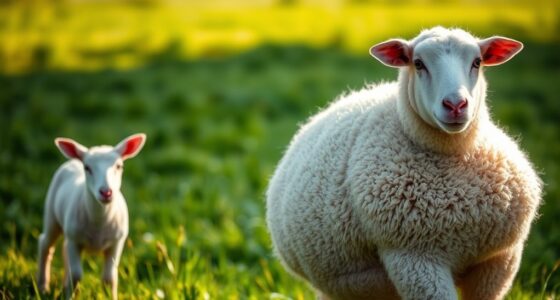To raise dual-purpose chickens for meat and eggs, choose hardy breeds like Rhode Island Reds, Sussex, or Plymouth Rocks that adapt well to your climate and space. Provide a safe, well-ventilated coop with enough room, nesting boxes, and perches. guarantee good protection from predators with sturdy fencing, and offer natural light plus supplemental lighting if needed. Proper coop design keeps your flock healthy and productive—keep exploring for detailed tips to set up your ideal poultry system.
Key Takeaways
- Select hardy, adaptable breeds like Rhode Island Reds, Sussex, or Plymouth Rocks for balanced egg production and meat quality.
- Design a secure, well-ventilated coop with adequate space, nesting boxes, and perches to promote health and reduce stress.
- Provide sufficient outdoor space (8-10 sq ft per bird) for foraging and exercise to support overall well-being.
- Ensure proper lighting and temperature control to maximize egg laying and maintain flock health year-round.
- Implement predator-proof fencing and secure access points to protect your chickens and ensure a safe environment.

Are you looking for a versatile addition to your farm or backyard? Raising dual-purpose chickens can be an excellent choice, offering both fresh eggs and meat without needing separate flocks. To get started, you’ll want to focus on selecting breeds that excel in both areas. Many breeds like Rhode Island Reds, Sussex, and Plymouth Rocks are well-known for their reliable egg production and quality meat. When choosing breeds, consider your climate, space, and the specific traits you value most—whether it’s size, temperament, or egg-laying rate. These breeds tend to be hardy, adaptable, and efficient, making them ideal for small farms or backyard setups.
Once you’ve picked your breeds, the next step is to think about coop design. A well-designed coop isn’t just about keeping your chickens safe; it also influences their overall health and productivity. Make sure your coop offers plenty of ventilation to prevent respiratory issues, especially if you live in humid or cold climates. Good ventilation doesn’t mean drafts, so incorporate windows or vents that can be opened and closed as needed. The coop should also have enough space—generally, about 3 to 4 square feet per bird inside the coop and 8 to 10 square feet per bird in an outdoor run. This prevents overcrowding, which can lead to stress and aggressive behavior. Perches should be high enough off the ground for roosting but easy for your chickens to access comfortably. Nesting boxes should be clean, private, and filled with straw or bedding material to encourage laying.
Lighting is another critical aspect of coop design. Dual-purpose chickens benefit from natural light, which influences their laying cycle and overall activity. If natural light is limited during winter months, consider installing supplemental lighting to maintain consistent egg production. Security features are equally important; sturdy fencing, lockable doors, and predator-proof hardware protect your flock from raccoons, foxes, or other pests. Additionally, access points for cleaning and maintenance should be easy to reach, making it simple to keep the coop sanitary and prevent disease.
Frequently Asked Questions
What Are the Best Dual-Purpose Chicken Breeds for Beginners?
For beginners, heritage breeds like Rhode Island Red and Plymouth Rock are excellent choices because they’re hardy and easy to care for. Hybrid varieties such as ISA Brown also work well, offering good egg production and meat quality. These breeds are adaptable, require minimal maintenance, and are forgiving for new chicken keepers. Your best bet is to start with a mix of heritage and hybrid chickens to learn and enjoy dual-purpose benefits.
How Do Dual-Purpose Chickens Compare to Specialized Meat or Egg Chickens?
You’ll find dual-purpose chickens offer a balanced mix, producing around 250 eggs annually and providing quality meat, which is impressive compared to specialized breeds. While meat chickens excel in rapid weight gain and egg layers focus on production, dual-purpose birds combine both traits, though they may not match the peak meat quality of broilers or the highest egg production of layers. This versatility makes them ideal for small farms or homesteads.
What Are Common Health Issues Specific to Dual-Purpose Breeds?
You might face broodiness challenges with dual-purpose breeds, as they tend to go broody more often, which can disrupt egg production. Nutritional deficiencies are also common if their diet isn’t balanced, leading to poor growth and egg quality. To prevent these issues, guarantee your chickens receive a well-rounded diet rich in essential vitamins and minerals, and monitor broody behavior closely to manage and minimize disruptions.
How Much Space Do Dual-Purpose Chickens Need per Bird?
You should provide about 4 to 6 square feet per dual-purpose chicken inside the coop. Focus on coop design that promotes space optimization, ensuring each bird has enough room to move comfortably and reduce stress. Incorporate perches, nesting boxes, and ventilation, so your chickens stay healthy. Adequate space helps prevent issues like pecking and disease, making your flock happier and more productive.
What Are the Long-Term Productivity Expectations for Dual-Purpose Chickens?
They say a bird in the hand is worth two in the bush, and with heritage breeds, you can expect steady, seasonal productivity over the years. Dual-purpose chickens typically produce eggs consistently for 2-3 years, with meat quality remaining good if you manage them well. Long-term, they provide a reliable source of eggs and meat, though productivity may decline as they age, so plan accordingly for your farm’s needs.
Conclusion
Raising dual-purpose chickens is like tending a versatile garden—each plant or bird offers multiple harvests. I once watched a backyard flock produce eggs and meat, proving their value beyond just one role. With just a few chickens, you can enjoy fresh eggs and tender meat, making your efforts worthwhile. Embrace these adaptable birds, and you’ll find your farm flourishing with sustainability and purpose, just like a well-tended garden that keeps giving back.









